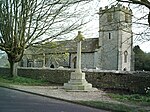All Saints Church, Nether Cerne
Buildings and structures completed in the 13th centuryChurch of England church buildings in DorsetChurches preserved by the Churches Conservation TrustGrade I listed churches in Dorset

All Saints Church in Nether Cerne, Dorset, England was built in the late 13th century. It is recorded in the National Heritage List for England as a designated Grade I listed building, and is a redundant church in the care of the Churches Conservation Trust. It was declared redundant on 1 December 1971, and was vested in the Trust on 8 March 1973.The church and adjacent manor house are built of bands of flint and stone. Most of the church dates from the 13th century, although the tower, with its pinnacles and gargoyle, and porch were added in the 15th.The interior of the church includes a melon-shaped 12th century font, believe to date form an earlier church on the same site.
Excerpt from the Wikipedia article All Saints Church, Nether Cerne (License: CC BY-SA 3.0, Authors, Images).All Saints Church, Nether Cerne
Geographical coordinates (GPS) Address Nearby Places Show on map
Geographical coordinates (GPS)
| Latitude | Longitude |
|---|---|
| N 50.782472222222 ° | E -2.4696111111111 ° |
Address
DT2 7AJ
England, United Kingdom
Open on Google Maps









